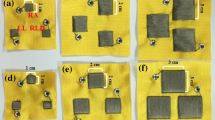Abstract
In the research related to heart rate measurement, few studies have been done using magnetic-induced conductivity sensing methods to measure the heart rate. The aim of this study was to analyze the effect of the position of a textile-based inductive coil sensor on the measurement of the heart rate. In order to assess the capability of the textile-based inductive coil sensor and the repeatability of measured cardiac muscle contractions, we proposed a new quality index based on the morphology of measured signals using a textile-based inductive coil sensor. We initially explored eight potential positions of the inductive sensor in a pilot experiment, followed by three sensor positions in the main experiment. A simultaneously measured electrocardiography (ECG) signal (Lead II) which was used as a reference signal for a comparison of the R-peak location with signals obtained from selected positions of the textile-based inductive coil sensor. The result of the main experiment indicated that the total quality index obtained from the sensor position ‘P3’, which was located 3 cm away from the left side from the center front line on the chest circumference line, was the highest (QI value = 1.30) among the three positions across all the subjects. This finding led us to conclude that (1) the position of the textile-based inductive coil sensor significantly affected the quality of the measurement results, and that (2) P3 would be the most appropriate position for the textile-based inductive coil sensor for heart rate measurements based on the magnetic-induced conductivity sensing principle.













Similar content being viewed by others
References
Department of Economics and Social Affairs. World population to 2300. http://www.un.org/esa/population/publications/longrange2/WorldPop2300final.pdf. Accessed 7 May 2013, 2004.
Cassell, J., Wearable technology market to exceed $6 Billion by 2016. http://imsresearch.com/press-release/Wearable_Technology_Market_to_Exceed_6_Billion_by_2016. Accessed 7 May 2013, 2012.
Shaoolian, G., 3 ways wearable tech can make you more profitable. http://www.forbes.com/sites/groupthink/2013/05/21/3-ways-wearable-tech-can-make-you-more-profitable. Accessed 4 June 2013, 2013.
Oum, J., Lee, S., Kim, D., and Hong, S., Non-contact heartbeat and respiration detector using capacitive sensor with colpitts oscillator. Electron. Lett. 44:87–89, 2008. doi:10.1049/el:20082336.
Steffen, M., and Leonhardt, S., Non-contact monitoring of heart and lung activity by magnetic induction measurement. Acta Polytech. 48:71–78, 2009.
Song, H., A design of woven textile electrode for monitoring the electrical activity of the heart in smart sportswear. Doctoral dissertation, Yonsei University, 2009.
Cho, H., A design of the modular clothing for ECG monitoring with optimal positions of electrodes. Doctoral dissertation, Yonsei University, 2011.
Song, H., Lee, J., Kang, D., Cho, H., Cho, H., Lee, J., and Lee, Y., Textile electrodes of jacquard woven fabrics for biosignal measurement. J. Text. Inst. 101:758–770, 2010. doi:10.1080/00405000903442086.
Cho, H., Koo, S., Lee, J., Cho, H., Kang, D., Song, H., Lee, J., Lee, K., and Lee, Y., Heart monitoring garments using textile electrodes for healthcare applications. J. Med. Syst. 35:189–201, 2009. doi:10.1007/s10916-009-9356-8.
Lymberis, A., and Dittmar, A., Advanced wearable health systems and applications - research and development efforts in the European union. Eng. Med. Biol. Mag., IEEE 26:29–33, 2007. doi:10.1109/MEMB.2007.364926.
Park, C., Chou, P., Bai, Y., Matthews, R., and Hibbs, A., An ultra-wearable, wireless, low power ECG monitoring system. Biomed. Circ. Syst. Conf. 2006. doi:10.1109/BIOCAS.2006.4600353.
Lobodzinski, S., and Laks, M., Comfortable textile-based electrocardiogram systems for very long-term monitoring. Cardiol. J. 15:477–480, 2008.
Maruyama, T., Makikawa, M., Shiozawa, N., and Fujiwara, Y., ECG Measurement using capacitive coupling electrodes for man–machine emotional communication. IEEE/ICME Int. Conf. 2007. doi:10.1109/ICCME.2007.4381760.
Lee, W., Yang, Y., Ke, T., Wei, C., Lee, H., Adaptive reduction of motion artifact in a portable ECG system. IEEE SENSORS 2010 Conference. doi:10.1109/ICSENS.2010.5690058, 2010.
Park, G., Electromagnetics. Books Hill, Seoul, pp. 124–136, 2010.
Vedru, J., Gordon, R., Hummal, L., and Trolla, J., Modelling of an inductive sensor of the Foucault cardiogram. Estonian J. Eng. 17:252–270, 2011. doi:10.3176/eng.2011.3.06.
Lee, J.-W., and Lee, J.H., Smart Wear: Heart activity monitoring system using inductive sensors. World of Electricity. The Korean Institute of Electrical Engineers. 62:21–27, 2013.
Aston, R., Principles of biomedical instrumentation and measurement. Merrill Publishing Company, New York, 1990.
Grant, R., The relationship between the anatomic position of the heart and the electrocardiogram: a criticism of “unipolar” electrocardiography. Circulation 1953:890–902, 1953. doi:10.1161/01.CIR.7.6.890.
Acknowledgments
This research was supported by the Mid-Career Researcher Program through the National Research Foundation of Korea funded by the Ministry of Science, ICT & Future Planning (NRF-2012R1A2A2A04045455).
Ethical Standards
The experiments comply with the current laws of the country in which they were performed.
Conflict of Interest
The authors declare that they have no conflict of interest.
Author information
Authors and Affiliations
Corresponding author
Rights and permissions
About this article
Cite this article
Koo, H.R., Lee, YJ., Gi, S. et al. The Effect of Textile-Based Inductive Coil Sensor Positions for Heart Rate Monitoring. J Med Syst 38, 2 (2014). https://doi.org/10.1007/s10916-013-0002-0
Received:
Accepted:
Published:
DOI: https://doi.org/10.1007/s10916-013-0002-0




